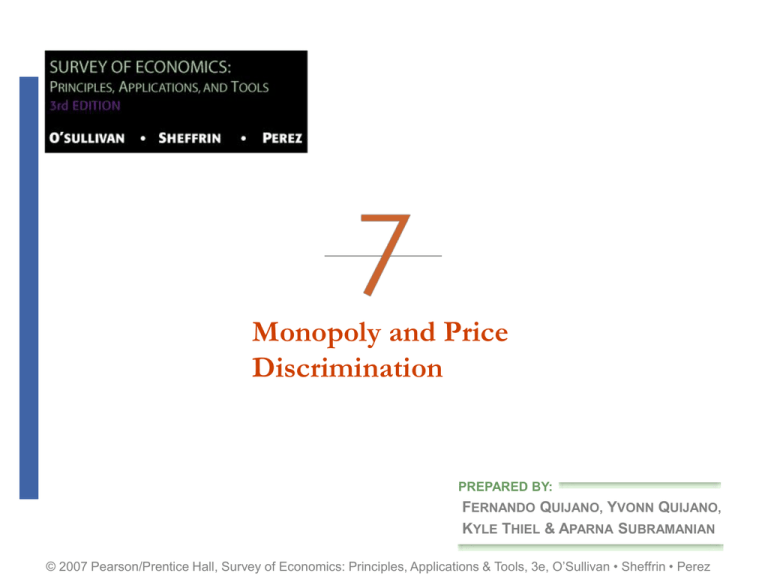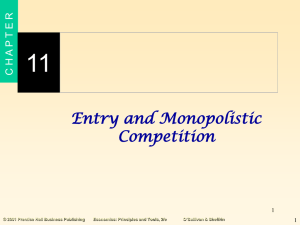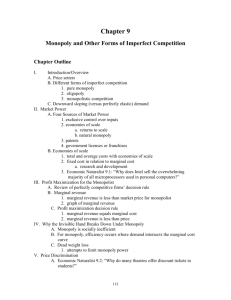
Monopoly and Price
Discrimination
PREPARED BY:
FERNANDO QUIJANO, YVONN QUIJANO,
KYLE THIEL & APARNA SUBRAMANIAN
© 2007 Pearson/Prentice Hall, Survey of Economics: Principles, Applications & Tools, 3e, O’Sullivan • Sheffrin • Perez
chapter
Monopoly and Price Discrimination
• monopoly
A market in which a single firm sells a
product that does not have any close
substitutes.
• market power
The ability of a firm to affect the price
of its product.
• barrier to entry
Something that prevents firms from
entering a profitable market.
© 2007 Pearson/Prentice Hall, Survey of Economics: Principles, Applications & Tools, 3e, O’Sullivan • Sheffrin • Perez
2 of 18
chapter
Monopoly and Price Discrimination
• patent
The exclusive right to sell a new good
for some period of time.
• network externalities
The value of a product to a consumer
increases with the number of other
consumers who use it.
• natural monopoly
A market in which the economies of
scale in production are so large that
only a single large firm can earn a
profit.
© 2007 Pearson/Prentice Hall, Survey of Economics: Principles, Applications & Tools, 3e, O’Sullivan • Sheffrin • Perez
3 of 18
chapter
7.1
THE MONOPOLIST’S OUTPUT DECISION
Total Revenue and Marginal Revenue
FIGURE 7.1
The Demand Curve and the MarginalRevenue Curve
© 2007 Pearson/Prentice Hall, Survey of Economics: Principles, Applications & Tools, 3e, O’Sullivan • Sheffrin • Perez
4 of 18
chapter
7.1
THE MONOPOLIST’S OUTPUT DECISION
A Formula for Marginal Revenue
marginal revenue = new price + (slope of demand curve × old quantity)
The first part of the formula is the good news, the money
received for the extra unit sold.
The second part is the bad news from selling one more unit, the
revenue lost by cutting the price for the original customers.
The revenue change equals the price change required to sell one
more unit—the slope of the demand curve, which is a negative
number—times the number of original customers who get a price
cut.
© 2007 Pearson/Prentice Hall, Survey of Economics: Principles, Applications & Tools, 3e, O’Sullivan • Sheffrin • Perez
5 of 18
chapter
7.1
THE MONOPOLIST’S OUTPUT DECISION
Using the Marginal Principle
A monopolist can use the marginal principle to decide
how much output to produce.
© 2007 Pearson/Prentice Hall, Survey of Economics: Principles, Applications & Tools, 3e, O’Sullivan • Sheffrin • Perez
6 of 18
chapter
7.1
THE MONOPOLIST’S OUTPUT DECISION
Using the Marginal Principle
► FIGURE 7.2
The Monopolist Picks
a Quantity and a Price
© 2007 Pearson/Prentice Hall, Survey of Economics: Principles, Applications & Tools, 3e, O’Sullivan • Sheffrin • Perez
7 of 18
chapter
7.1
THE MONOPOLIST’S OUTPUT DECISION
Using the Marginal Principle
The three-step process explaining how a monopolist
picks a quantity and how to compute the monopoly
profit is as follows:
1 Find the quantity that satisfies the marginal
principle, that is, the quantity at which marginal
revenue equals marginal cost.
2 Using the demand curve, find the price associated
with the monopolist’s chosen quantity.
3 Compute the monopolist’s profit. The profit per unit
sold equals the price minus the average cost, and
the total profit equals the profit per unit times the
number of units sold.
© 2007 Pearson/Prentice Hall, Survey of Economics: Principles, Applications & Tools, 3e, O’Sullivan • Sheffrin • Perez
8 of 18
chapter
7.2
THE CONSEQUENCES OF MONOPOLY
Monopoly versus Perfect Competition
FIGURE 7.3
Monopoly Versus Perfect Competition:
Its Effect on Price and Quantity
© 2007 Pearson/Prentice Hall, Survey of Economics: Principles, Applications & Tools, 3e, O’Sullivan • Sheffrin • Perez
9 of 18
chapter
7.2
THE CONSEQUENCES OF MONOPOLY
Rent Seeking: Using Resources to Get Monopoly Power
• rent seeking
The process of using public policy to
gain economic profit.
Monopoly and Public Policy
Given the consequences of monopoly, governments use a number of
policies to intervene in markets that are dominated by a single firm or could
become a monopoly.
© 2007 Pearson/Prentice Hall, Survey of Economics: Principles, Applications & Tools, 3e, O’Sullivan • Sheffrin • Perez 10 of 18
chapter
ENDING THE MONOPOLY ON INTERNET REGISTRATION
APPLYING THE CONCEPTS #1: What happens when a monopoly
ends?
For an illustration of the inefficiency of monopoly, we can look at what happens
when a government-sanctioned monopoly ends. In February 1999, the U.S.
government announced plans to end the five-year monopoly held by Network
Solutions Inc. for registering Internet addresses. Network Solutions had an
exclusive government contract to register Web addresses, also known as domain
names, ending in .net, .org, .edu, and .com.
• The company registered almost 2 million names in 1998, collecting $70 for
each address and charging an annual renewal fee of $35.
• An entering firm had to meet strict requirements for security and backup
measures and liability insurance.
• Two new competitors, Register.com and Tucows.com, cut prices to
between $10 and $15 per year. The new firms also offered longer
registration periods and permitted more characters in each domain name.
• Network Solutions, the original monopolist, quickly matched its
competitors’ lower prices and expanded service options.
© 2007 Pearson/Prentice Hall, Survey of Economics: Principles, Applications & Tools, 3e, O’Sullivan • Sheffrin • Perez 11 of 18
chapter
7.3
PATENTS AND MONOPOLY POWER
Incentives for Innovation
Trade-Offs from Patents
It is sensible for a government to grant a patent for a product
that would otherwise not be developed, but it is not sensible for
other products. Unfortunately, no one knows in advance whether
a particular product would be developed without a patent, so the
government can’t be selective in granting patents. In some
cases, patents lead to new products, while in other cases
patents merely prolong monopoly power.
© 2007 Pearson/Prentice Hall, Survey of Economics: Principles, Applications & Tools, 3e, O’Sullivan • Sheffrin • Perez 12 of 18
chapter
7.4
PRICE DISCRIMINATION
• price discrimination
The practice of selling a good at
different prices to different
consumers.
Although price discrimination is widespread, it is not
always possible. A firm has an opportunity for price
discrimination if three conditions are met:
1 Market power.
2 Different consumer groups.
3 Resale is not possible.
© 2007 Pearson/Prentice Hall, Survey of Economics: Principles, Applications & Tools, 3e, O’Sullivan • Sheffrin • Perez 13 of 18
chapter
BRIBING THE MAKERS OF GENERIC DRUGS
APPLYING THE CONCEPTS #2: What is the value of a monopoly?
When the patent for a brand-name drug expires, other firms introduce generic
versions of the drug. The generics are virtually identical to the original branded
drug, but they sell at a much lower price. The producers of branded drugs have an
incentive to delay the introduction of generic drugs and sometimes use illegal
means to do so.
• In recent years, the Federal Trade Commission (FTC) has investigated allegations
that the makers of branded drugs made deals with generic suppliers to keep
generics off the market.
• Alleged practices included cash payments and exclusive licenses for new versions
of the branded drug.
• In 2003, the FTC ruled that Schering-Plough paid Upsher-Smith $60 million to
delay the introduction of a low-price alternative to its prescription drug K-Dur-20,
which is used to treat people with low potassium.
• Another tactic used by the producers of branded drugs is to claim that generics are
not as good as the branded drug. Because generic versions are virtually identical
to the branded drugs, such claims are not based on science.
© 2007 Pearson/Prentice Hall, Survey of Economics: Principles, Applications & Tools, 3e, O’Sullivan • Sheffrin • Perez 14 of 18
chapter
7.4
PRICE DISCRIMINATION
Senior Discounts in Restaurants
FIGURE 7.4
The Marginal Principle and
Price Discrimination
Price Discrimination and the Elasticity of Demand
© 2007 Pearson/Prentice Hall, Survey of Economics: Principles, Applications & Tools, 3e, O’Sullivan • Sheffrin • Perez 15 of 18
chapter
PAYING FOR A COLD SOFT DRINK ON A HOT DAY
APPLYING THE CONCEPTS #3: When does a firm have an opportunity
to charge different prices to different consumers?
On a hot day, are you willing to pay more than you normally would for an
ice-cold can of Coke?
• Coca-Cola Company developed a high-tech vending machine,
complete with heat sensors and microchips, that charges a higher
price when the weather is hot. According to Douglas Ivester, the
head of Coca-Cola, the desire for a cold drink increases when it is
hot, so “it is fair that it should be more expensive. The machine will
simply make the process more automatic.”
• The announcement of the new vending machine led to howls of
protest from consumers.
• In response, Coca-Cola Company said that it would not actually
use the new machine.
• By the beginning of 2006, Coca-Cola had not used the new
vending machines.
© 2007 Pearson/Prentice Hall, Survey of Economics: Principles, Applications & Tools, 3e, O’Sullivan • Sheffrin • Perez 16 of 18
chapter
THE PRICING OF MOVIE ADMISSION AND POPCORN
APPLYING THE CONCEPTS #4: When does price discrimination
work?
Why do senior citizens pay less than everyone else for admission to a
movie, but pay the same as everyone else for popcorn?
• A senior discount is an act of profit maximization.
• A theater divides its consumers into two groups—seniors and
others—and offers a discount to seniors.
• This price discrimination in favor of senior citizens increases the
theater’s profit.
Why don’t theaters offer a senior discount for popcorn?
• Popcorn can be easily transferred from one customer to another.
• The theater wouldn’t sell as much popcorn at the regular price,
and the theater’s profit would decrease.
As long as ticket takers check consumers’ admissions tickets,
admission to the movie is not transferable.
© 2007 Pearson/Prentice Hall, Survey of Economics: Principles, Applications & Tools, 3e, O’Sullivan • Sheffrin • Perez 17 of 18
chapter
HARDBACK BOOKS ARE RELATIVELY EXPENSIVE
APPLYING THE CONCEPTS #5: What types of consumers pay relatively high
prices?
Why is the price of the hardback edition of The Da Vinci
Code three times the price of the paperback edition?
• The cost of producing a hardback book is only about 20 percent higher than
producing a paperback.
• The Da Vinci Code by Dan Brown sold as a hardback in 2003 at a price of $25.
• Three years later, it sold as a paperback at a price of $8.
Why are hardbacks so expensive compared to paperbacks?
• Booksellers use hardbacks and paperbacks to distinguish between two types of
consumers: those who are willing to pay a lot and those who are willing to pay a
little.
The pricing of hardback and paperback books is another example of price
discrimination, with consumers with less elastic demand paying a higher price.
© 2007 Pearson/Prentice Hall, Survey of Economics: Principles, Applications & Tools, 3e, O’Sullivan • Sheffrin • Perez 18 of 18









